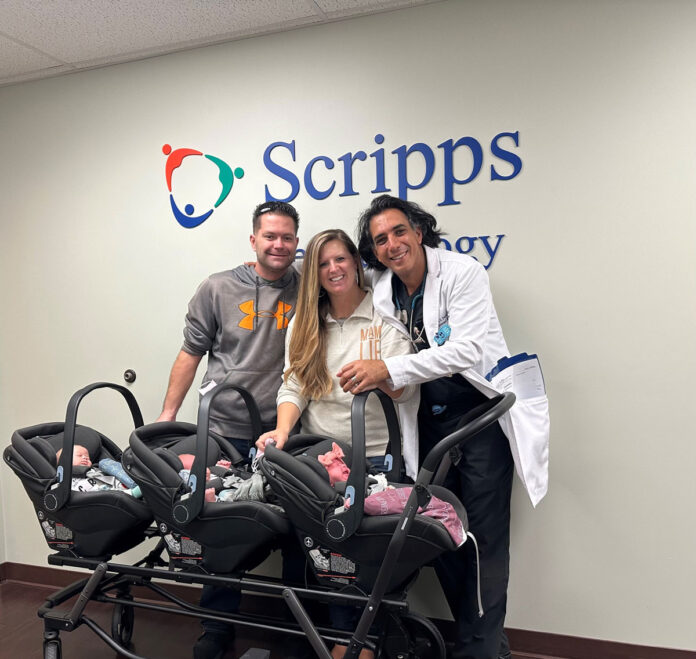
It took more than a decade for Otay Ranch couple Amanda and Tommy Gibson to start a family, but they found themselves expecting last year and in October 2022, she delivered triplets.
The Gibson babies are doing well, but Ansley, Axton and Asher had a complicated journey coming into this world.
Amanda and Tommy Gibson have been married for 18 years and began trying to have children four to five years into their marriage. Both thinking it would happen right away and they would be parents, Amanda Gibson said year after year, the disappointment grew.
Living in North Carolina at the time, Amanda Gibson said they went to a fertility specialist.
“They said it was unexplained. They could not find anything wrong,” she said.
They began the journey again after they relocated here for work, went through all the testing again, and there was still no explanation for her not having children.
“I think that is more frustrating than an actual diagnosis,” she said. “It is like we do not know what is wrong and there is nothing to fix. We had considered in vitro fertilization, but I knew it was a last-ditch effort. I was afraid of it failing, I guess. Obviously, it did not. We did IVF and ended up with 12 embryos. We implanted two of those. One of them ended up splitting, we had both of those plus one, ending up with our little triplets.”
They have two boys, and one girl. Ansley is the girl, and Axton and Asher are identical boys. Amanda said getting the three little ones and having a family was not an easy road. And as a nurse, she understood the risks involved.
“At 12 weeks I started bleeding really bad,” she said, adding she called her doctor and headed for Scripps Chula Vista’s emergency room. “I was just waiting for bad news. It is a super high risk pregnancy already, and that is the window when many miscarriages happen. I was hoping for the best, but assuming the worst. They did an ultrasound in the emergency room, and there they were, all three babies kicking and moving around.”
Her obstetrician and perinatologist, Dr. Sean Daneshmand, medical director of the Perinatology Program at Scripps Clinic, diagnosed the cause.
“That is when they discovered that I had placenta previa,” she said. “Baby A, Asher, his placenta was really, really low and released some blood. But with placenta previa, it makes a high risk pregnancy a higher risk.”
Gibson said shortly after that, Dr. Daneshmand pulled her from work.
“He said if we were going to carry these babies to what we consider term for triplets you need to be home and take it easy for the rest of this pregnancy,” she said.
At 25 weeks, she began bleeding again. It was placenta previa and she spent a week in the hospital, got the NICU prepped.
“Just in case we had to deliver them at 25 weeks, which is not ideal at all,” she said. “They did fine. They were super active and hanging out. They knew it was not time to be born yet, so the discharged me and I ended up having them at 33 weeks.”
Having triplets in and of itself qualifies as a high-risk pregnancy. But combining that with placenta previa – and with one of the other babies being positioned in the breech position (bottom first) – added even more layers of complexity. Dr. Daneshmand delivered all three safely via C-section at Scripps La Jolla on Oct. 13 – premature at 33 weeks and weighing in at 5 pounds 4 ounces; 4 pounds 10 ounces; and 4 pounds 9 ounces.
Daneshmand said this is about a beautiful couple who have been trying to have children for a long time.
“They wound up with three beautiful babies, but with that comes a lot of fear and anxiety,” he said. “One of the biggest fears is if it is going to work, are these babies going to be able to survive. And as a physician, we share all the possible complications for the mom, but also the babies. With triplets there are much high complications than a single pregnancy.”
Daneshmand said there is more risk of high blood pressure, (preeclampsia) and gestational diabetes. Amanda had both gestational diabetes during the pregnancy and preeclampsia after birth. He said placenta previa is more common with IVF pregnancies.
“The biggest risk factor is premature labor,” he said. “Just the fear in this alone after they have gone through so much is really traumatizing on the mom’s brain. But one of the most important factors when it applies to care is trust between the providers and the patient. Amanda and Tommy are great people. Amanda is a nurse herself, and she was fluid the entire time. It was an amazing relationship. One of those families that trust in the medical system, trust in the care I was giving, and that makes for a great recipe for better outcomes, even when there are complications.”
Daneshmand said at 33 weeks, they decided to deliver.
“Amanda was really immobilized. She could barely move anymore. She was experiencing contractions. In this case, Baby B was breech, upside down, so we ended delivering via C-section. She did very well post operatively, but then she came back a few days later when she started experiencing elevated blood pressure,” he said.
Daneshmand said there were many trips to the emergency room for the couple, but said Amanda was a “champ.” And then the triplets got respiratory syncytial virus.
“And both Tommy and Amanda got sick. So, they spent a lot of time at Rady Children’s,” he said. “One of the amazing collaborations that we have is with Rady Children’s Hospital. Rady Children’s employees work closely with the Scripps team, managing our neonatal intensive care units across the four hospitals where we provide maternity care.”
“These babies spent a couple of weeks in NICU, and they were thriving, and this is the dream of this family,” he continued. “Amanda almost every other day sends me pictures of the babies.”
Daneshmand said the important thing is at Scripps, they developed a team of people.
“This is very unique to our field,” he said. “This is typically seen with patients in oncology, or transplant divisions. But in perinatology it is very rare to have a nurse navigator. It is not a very profitable business to have a nurse navigator, someone who is a nurse, but also really watching the patient making sure they do frequent mental health screenings, the patient knows all their appointments, that go-to person where their questions will be answered.”
Amanda Gibson said that having a team who knows who she is, what she is going through, where she is at, all these things made her difficult pregnancy easier. She never worried about seeing a strange doctor, and she had a nurse navigator that helped her with what she needed. And, that the support of entire perinatology team was more than helpful, it was comforting through every stage of the pregnancy.
“I told Dr. Daneshmand every week that I actually look forward to my appointment. It would completely reset me, mentally, emotionally, and physically,” she said. “It was like walking in and seeing friends every couple of weeks. It was the same super supportive people. He [Daneshmand] would make sure the babies were okay, that I was okay physically, then he would spend 20-30 minutes just talking to me. He would make sure that I was mentally okay and staying positive.”
Amanda Gibson said now the babies are home, and everyone is healthy and happy.














